2024 Disease Season reaches its height; recovering from abiotic stresses; perennial ryegrass declines quickly; dollar spot on Kentucky bluegrass intensifies; brown patch looking neither brown nor patchy; algae explosion on putting greens.
Thank you to all those that attended the 2024 Purdue Turf & Landscape Field Day. Although the tent and infrastructure were marred by weather, luckily the weather held off for the actual event, with exemplary attendance (over 400), great conversation and education. Special thanks to our fantastic MRTF board members who jumped in and got the show back on the road. To read more about the event, click here.
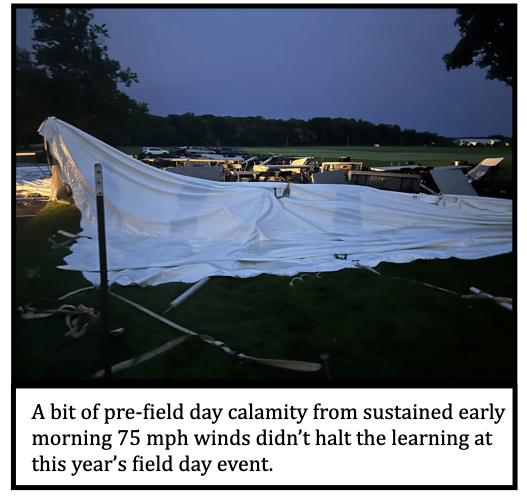
Weather
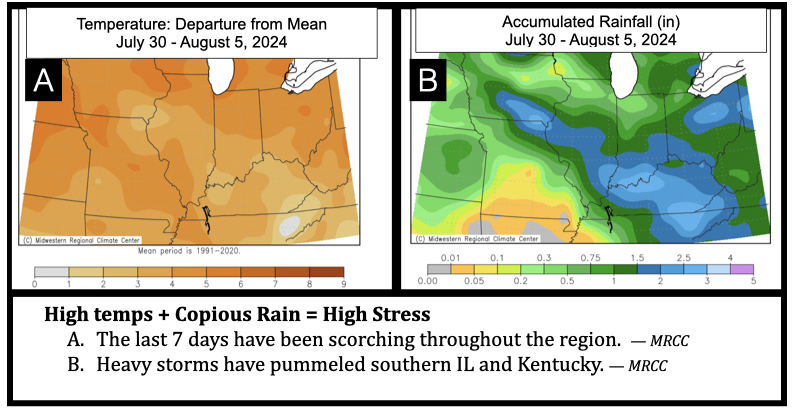
The start of August and last 10+ days of July has been a brutal stretch for turfgrass health. The last week has been blazingly hot and disgustingly humid throughout the region. Temperatures 6+ degrees above average were common, with “low” temperatures not getting out of the 70s. Soil temperatures have responded with average 2” soil temperatures in the mid 80s throughout much of the state. Dewpoints also hovered in the high 60s, making the air thick, uncomfortable, and a breeding ground for disease activity. Rainfall has also been in excess over the last month, with heavy downpours hitting the region in late July, resulting in above average precipitation recorded for July in Indianapolis (+1.5 – 2”), the western part of IN, and central Illinois on into St. Louis. Health of cool season grasses is at its lowest point of the season, with the sustained environment of high heat, high humidity, and high soil temperatures over the past two months resulting in a weakened plant predisposed to abiotic disorders and diseases. Come on September…
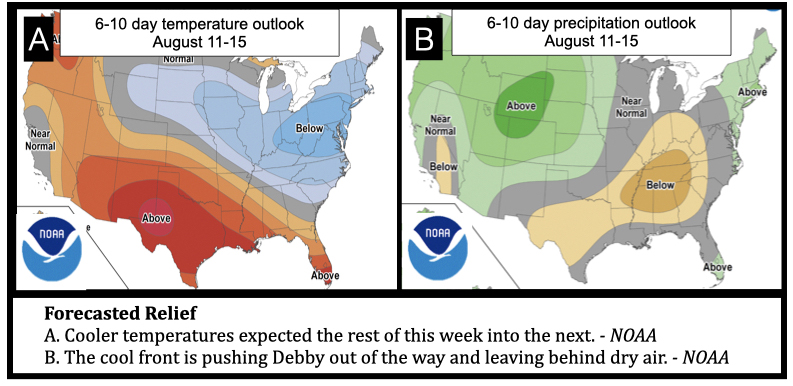
The forecast starting mid-week and over the next seven days appears to offer needed relief and recovery. Below average temperatures are expected to last into the middle of the month along with drier weather, fueled in part by a strong cool front staving off the remnants of Debby. Longer range forecasts for the latter half of August indicate a return to higher temperatures so let the turfgrass and us enjoy the summer reprieve while we can.
Negating the Abiotic Stresses
A few thoughts about the next week of cooler temperatures and potential action items to help make it to the fall.
Fertilizer
Lawns – If they haven’t been fertilized since spring, lawns may be a bit nitrogen deficient after a full season of mowing and heavy rainfall. This is especially true of younger lawns. Our tall fescue plot seeded last fall is demonstrating pronounced nutrient deficiency and disease symptoms compared to a 20-year-old tall fescue area right next door. Applying 0.25 – 0.5 lb N/1000 sq ft this week shouldn’t spike disease and may in reality reduce it.
Golf – Similarly on golf putting greens, a slight uptick in the spoonfeeding rate (i.e. 0.1 up to 0.125 lb N/1000 sq ft) may help stave off anthracnose and algae. Switching to ammonium sulfate now on greens is not recommended and analyze your fertilizer program to reduce the amount of sulfur application. This close to the finish line, we don’t want to spark black layer when the heat, humidity and rainfall do return.
Water
If humidity drops and the air goes dry, the expectation should be that turfgrass will go brown into drought dormancy fairly quick. Roots are extremely short now due to waterlogged, hot soils and 90 F+ heat. Lawns with heavier clay soils will be especially susceptible to “flash drought” symptoms, as the grass will want to start growing with the cooler temperatures but not have the roots or water supply to sustain it. To keep it green, the irrigation system may need to come back on, but remember that lawns can go drought dormant for a time and still come back.
Cultivation/Aerification
Lawns – Too early.
Golf – On golf greens, solid tining or venting would be of great value during this cool period. Keep on topdressing. Pump the brakes, however, before considering slapping on the verticutting units or grooved rollers just yet. A week of relief doesn’t mean the diapers can be taken off quite yet.
Perennial Ryegrass – Bearer of All Diseases
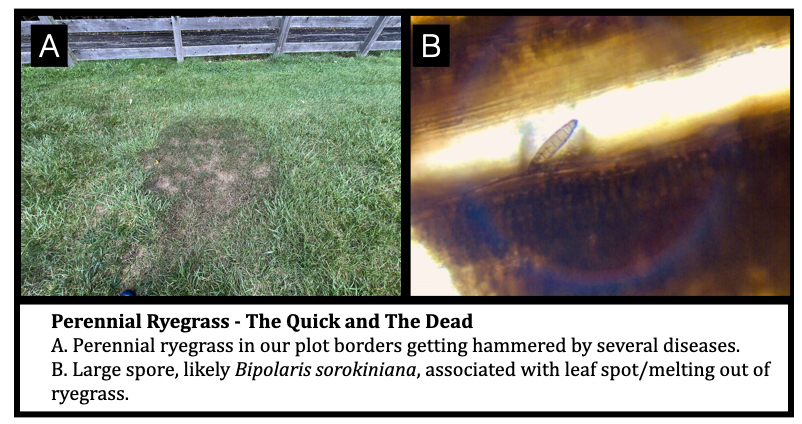
Perennial ryegrass that is unprotected by fungicides is taking a beating this summer. On home lawns, I commonly refer to this species as the “Quick and the Dead”, germinating in seven days but dying in two during the summer. The quick germination time of the ryegrasses are very appealing, particularly in a contractor’s mix or similar where the idea is to get some green growth as fast as possible either to repair an area or to establish a new lawn. For a pathologist, perennial ryegrass is a bearer of a multitude of gifts, with susceptibility to a wondrous variety of diseases.
We have received several samples over the last few weeks with a mixed lawn of several species including perennial ryegrass, some of which were seeded last fall or this recent spring. Invariably, the perennial ryegrass is decimated with diseases such as brown patch, leaf spot (no gray leaf spot observed yet), Pythium and other maladies. Breeding efforts at other universities are focusing on enhancing the disease resistance of perennial ryegrass, so in the future the following recommendation may change. For now, however, perennial ryegrass used as the principal component of a home lawn or higher cut area is not a sustainable, fiscally viable option in the intense heat of an Indiana summer.
Brown Patch on Tall Fescue – The Impressionist
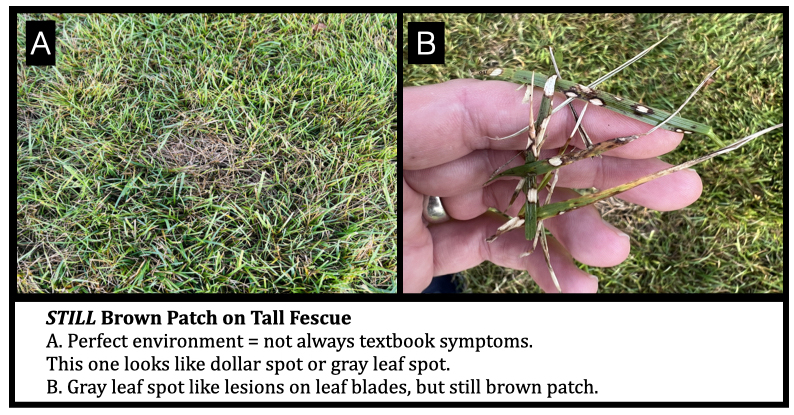
Rhizoctonia spp. causing brown patch have turned into Frank Caliendo, giving stark impressions of other disease symptoms in tall fescue. While the textbook smoke-ring symptoms are present in some cases, we have also observed symptoms more reminiscent of other diseases. Round, white to tan patches only 4-6 inches wide were noticed last week on our fall seeded tall fescue along with distinct tufts of mycelium. These were similar to symptoms of dollar spot, which I’ve never observed on turf-type tall fescue. In addition, many of the leaf lesions were not scalloped, but instead appeared similar to the circular and oval spots indicating potential infection by the gray leaf spot pathogen. Gray leaf spot has just been reported by OSU colleagues in Ohio a few days ago and by NCSU colleagues in NC in late July). Upon inspection under the microscope, these symptoms ended up still being the constant plague of good ole’ brown patch, which evidently is so excited by the weather that it is going against the textbook and producing a bevy of symptom types. This being said, we are still actively scouting and monitoring for gray leaf spot on tall fescue and perennial ryegrass in the state, which would start to develop symptoms when the calendar flips to August.
Dollar Spot Taking Hold of Kentucky Bluegrass
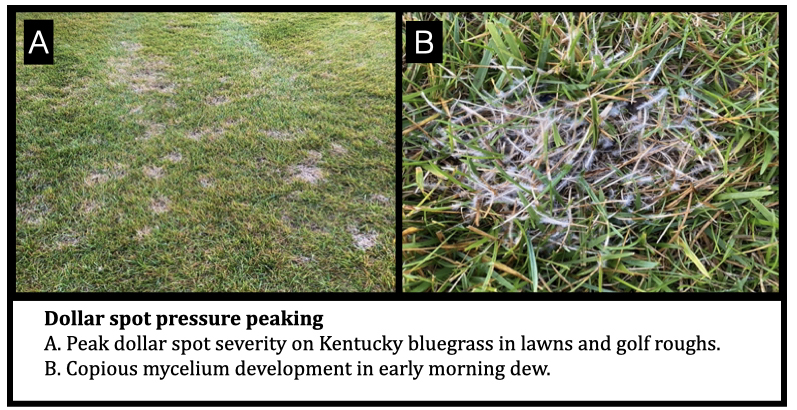
The battle with dollar spot is a constant one across most of the season, but the pressure has hit a high note in early August. The Smith-Kerns model reached its highest statewide probability index since late August of last year, and Kentucky bluegrass, which may have been mildly affected before, is now getting hammered. Reports and samples from lawn care companies and homeowners have been frequent in the last two weeks. Curative fungicides effective for this disease on residential lawns include fluxapyroxad (Xzemplar) and the DMI fungicides. Granular fungicides do not work as effectively as sprayable for curative dollar spot control, and in curative situations spraying at higher water carrier volumes (at least 1 gallon/1000 sq ft) is suggested to enhance recovery. Dollar spot is also a low nitrogen disease and an indication that a nitrogen application is needed. On dollar spot affected lawns, an application of 0.5 – 0.75 lb N/1000 sq ft can enhance recovery and in some cases reduce or eliminate the need for fungicide application.
Algae on Putting Greens
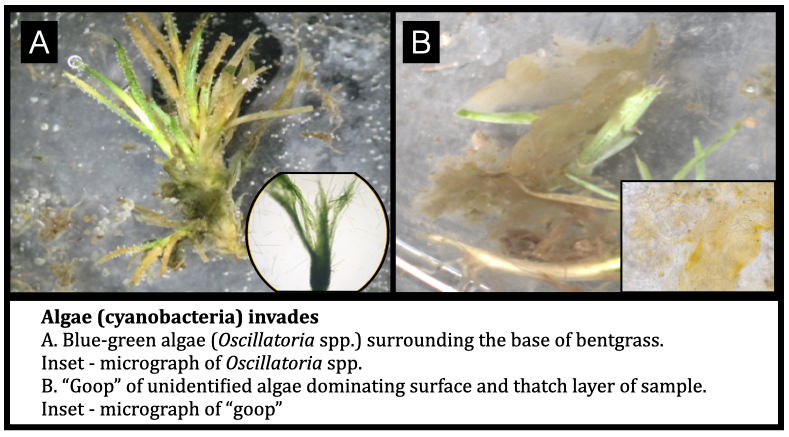
Along with soggy hot root syndrome, algae infestation has been a constant presence in putting green samples coming into the lab over the past few weeks. Unlike last year, we are not observing the ‘yellow spot’ or distinct chlorosis associated with algae infestation but the presence of Oscillatoria, Phormidium and even Nostoc spp. on greens has been prevalent enough to be a drag on bentgrass health. Some of these algae (aka cyanobacteria) have been shown to produce a phytotoxic secondary metabolite to gain a competitive advantage and are concerning when in high abundance wrapped around leaf sheaths and throughout the thatch layer. Treatment with the phosphites, chlorothalonil, mancozeb and/or thiram should aid in control, along with attempting to dry down the surface layer through routine venting.
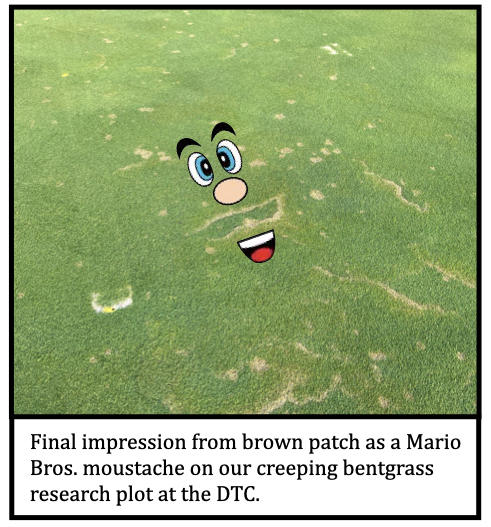
Lee Miller
Extension Turfgrass Pathologist – Purdue University 
Follow on Twitter: @purdueturfpath